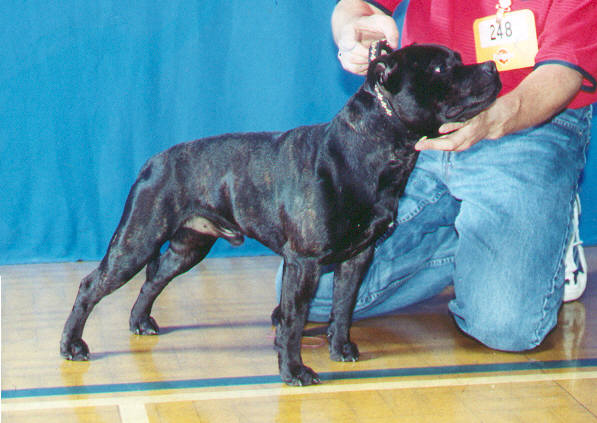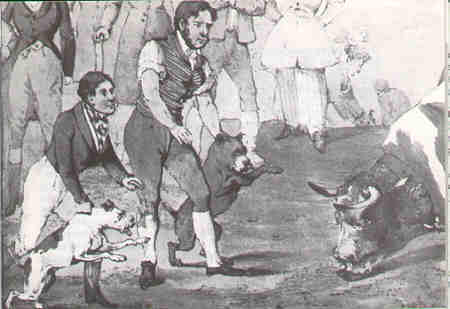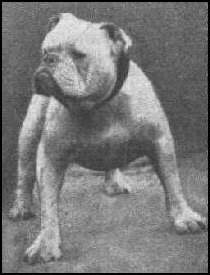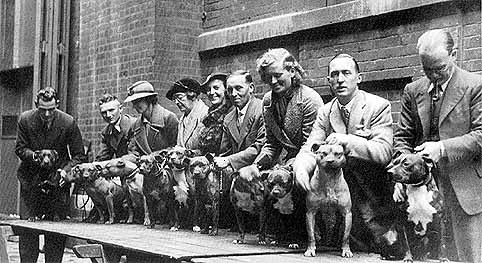









The Stafford Brew
There are many bona fide and comprehensive accounts of the history of the Staffordshire Bull Terrier. This is section of www.homebrewedstaffords.com does not attempt to educate visitors on the complete history, but provides a little food for thought that will hopefully compliment the refreshing, well-balanced brew we know as the modern Staffordshire Bull Terrier.

Eng. Ch. Marstaff Dragon Lives On
Exhibits Standard, Balanced, Functional Construction!
A REFRESHINGLY BREWED STAFFORD!
The Very Basic Recipe:
The Stafford Brew historically consists of two, simple ingredients:
1 part bulldog
1 part terrier
The modern interpretation of the way in which these two ingredients are combined and the historical context of the ingredients are the most important considerations in understanding what a Stafford is.....that is,
What a Stafford should be.
The
"bulldog"

It is important to know that the "bulldog" that originally went into the making of the Stafford is not the Bulldog we know today. The 19th century "bulldogs" of England were built more like the smaller, more lean American Bulldogs, and less like the modern AKC/Kennel Club Bulldogs used for companionship and show.
1820 - Bull Baiting
These original bulldogs actually "engaged" full-grown bulls for "sport." Think about that for a moment.......They had to be extremely powerful, yet also very agile. Further, they had to exhibit tremendous will in order to stay alive.

Not withstanding the virtues of the modern Bulldog, one must admit that if placed in a bout with a big, mean, pissed-off bull (we've all seen the rodeos), he'd be much too slow and cumbersome to make a move before being thrown in the air by his competitor. Further, strength does an animal no good without wind. If the bulldog is gasping for air after 5 minutes, he has lost the contest.
The Stafford descended from no such creature, though some may look as though they did.
The makings of a modern Bulldog
("Transitional" style)
Side note: Several years ago I witnessed a Miniature Schnauzer (mine) jump onto the back of a Bulldog 4 times his size when "Bo", the neighbor's Bulldog, chased me through my front yard and into my house. I couldn't close the door behind me quick enough. Upon entering the house, I fell up the stairs, and the Bulldog was on my heels. Just when I thought I'd been had, here came "Blitz Von Bark" (yeah, that actually was his name) to the rescue. I feared for the Schnauzer's life because I knew that the Bulldog could chew him up in an instant. But "Bo," was so winded by the brief chase that when she entered the house my Schnauzer went flying (quite literally) onto her from the top of the stairs. For a good 20 seconds, it was like watching a swarm of bees attack a bear that had just awaken from hibernation. I reached into the mess, grabbed my 15 pound terrier by the collar and threw him back up the steps as I watched the bewildered "Bo" shake her head a few times (she wasn't really hurt, mind you) and stumble back outside not knowing what hit her.
Obviously, my point is not that we should test dogs on bulls, or god forbid, other dogs, but that the historical significance of such consideration will help us better understand the make-up of our modern Staffords.
STAFFORDS DID NOT EVOLVE FROM HEAVY, EXAGGERATED BULLDOGS. WE SHOULD NOT BREED STAFFORDS WHO LOOK AS THOUGH THEY DID.
The "terrier"

When bull baiting was declared illegal in England, the "sporting folk" took their beloved bulldogs and concentrated more on dog fighting in order to quell their thirst for blood. As the "game" of dog fighting was refined, a faster, even more agile dog than the original bulldog was needed to be competitive. Enter the Terrier.
Sketch of an old-style
British terrier - Efficient
Though I don't have any more stories of valiant exhibitions by terriers that I care to put into print (and the Schnauzer isn't even a "true" terrier...at least, not a British one), consider for a moment the lot of an old-school, 19th century British terrier. These dogs were fiery beyond compare. Without candy-coating it, we realize that they were bred to snatch up other living creatures with sharp teeth, and shake the hell out of them. Size was of no matter to these terriers. Sometimes the game was relatively small, like a rat. Sometimes it was big-and-mean like a badger. A working terrier approaches either without prejudice, only knowing that there is nothing on the face of this earth that can't be whipped. Sometimes the terrier is wrong, but you can't tell him that until he is dead.
Quite unlike the juxtaposition of the original bulldogs with the modern Bulldog, there are many terriers today, who although not selectively bred for tenacity, still carry that trademark "fire in the belly." Just a few moments with the Scotties, the Fox Terriers, or even the grandiose Kerry Blues at modern dog show can prove to be a reality check for anyone doubting the confidence of a terrier when dealing with other animals.
The tenacious, little terriers were bred with the strong, willful bulldogs in order to come up with the ultimate fighting dog who could also be used for the occasional game of badger baiting. Plain and simple, it was here that the Staffordshire Bull Terrier found his roots.
Incidentally, the United States had it's own little concoction in the making that was the result of breeding the ancestors of the American Bulldog (originally, mastiffs / bulldogs from Great Britain) with the Terriers that had come over from England as well. Across the Atlantic Ocean, the American Pit Bull Terrier was born.
The balanced
blend:
No one actually deliberated and suggested, "Let's create a breed called the Staffordshire Bull Terrier." The British fighting dogs of the late 19th and early 20th century inadvertently evolved into the Stafford. Originally referred to by names including "Bull-and-Terrier," "Half-and-half," "Pit dog," and even "Staffordshire Bulldog," these newly blended dogs became very popular in dog fighting and badger baiting circles. When they grew to sufficient numbers the practice of crossing the bulldog with the terrier ceased, and a single "breed" began to evolve by breeding Bull-and-Terrier to Bull-and-Terrier. Common, predictable characteristics were a result of breeding game winning dogs with game winning bitches.
Ch. Gentleman Jim -
Multi-Purpose Stafford
Though Great Britain declared dog fighting illegal in 1835, the law wasn't strictly enforced until decades later. As the laws were tightened, a contingency of "sporting men" were moved to find a respectable lot for their beloved animals. These dogs had become important members of the family, and as ironic as it might sound, many were lovingly cared for by their owners, particularly considering the affection and loyalty they in turn showed their families. The Bull-and-Terrier fancy did not want these dogs to fade into history with the abatement of dog fighting.
In order to preserve the Bull-and-Terrier, the same fraternity who developed it in the underground circles decided to legitimize its existence and proposed that it continue its life in the most public of arenas, the modern show ring. This would allow them to continue to breed and refine their dogs while competing in an acceptable sport, meanwhile displacing the public attention that was given to dog fighting which still continued "under the radar." Many of the early show Staffords competed in the pits as well.

Dog Show 1937
The long and short of it is that the name "Staffordshire Bull Terrier" was settled upon, and the English Kennel Club began recognizing the Stafford as a breed eligible for show in 1935.
Things to consider today:
It has been said by some (not me, mind you) that "The modern American Cocker Spaniel couldn't hunt his way to the butcher's counter in a super market." Their point is that the original dog is gone and has been replaced by a pretty shell. This is not the intent of the game at all.
The conformation ring is supposed to be the place where the top specimens of each breed are chosen so that the "best" can be bred to the "best." This way, the breed will consequently improve. Original function for most dogs can not be judged in the ring, therefore a lot of theory has to be applied. If the theory is sound, (e.g. A sight hound's construction should be lean and efficient so that he can run swiftly for a long period of time if needed), then conformation shows are fulfilling their purpose, always keeping in mind original intent above all else. If the theory is grossly flawed (e.g. Big, bulky muscles on a fighting dog look good, so they must be better than functional ones) then we're all just pissing into the wind.
Physical construction of the exhibit is primarily what we judge at dog shows. The physical makeup of a dog originally intended for fighting is of utmost importance. It has been beaten into our brains that even though we do not practice the original intent of our dogs (regardless of the breed) we should be breeding them as if we were.
Is this what we are doing? Do we stop to consider the cold realities of having a dog that was originally bred for blood sport? We don't have to enjoy it. In fact, we shouldn't. But if the history wasn't there, then the Stafford wouldn't be here. What we must do is understand it, and apply a little bit of sound theory in our dealings.
Consider again, the modern Bulldog. If the men from 1820 in the drawing above found out what their Bulldogs have become, and saw that they are being shown in the Non-Sporting group today, their ghosts would come back and haunt all our asses!
When it comes to Staffords, we can not redefine the proper balance in blending the bull and the terrier just to suit our uneducated tastes. The proper balance has already been dictated by the function. Like it or not, it is predetermined.
There have been literally thousands of discussions and articles directly and indirectly addressing the fact that many people believe that the Staffordshire Bull Terrier is heading in the direction of the Bulldog. The Breed Standard gives us some simple guidelines for the appropriate physical proportions of the Staffordshire Bull Terrier. These proportions are not exactly what the breed "founders" had in mind for the ultimate Stafford. Their dogs actually carried fewer pounds per inch of height. However, sticking to the guidelines of the Standard today will help ensure the application of sound theory with regard to form and function. Thus avoiding simple opinions born of modern taste.
Bigger is not always better. Extremes are not the necessarily the best way to go. A brief study of some of the more popular historic photos reveals the functional balance of bulldog and terrier that was present in the early Staffords who earned their keep in more than one type of ring. We should consider the material provided for us by those who lived with "working" Staffords. We should remember the ancient adage of moderation being the key.
And above all, we should commit ourselves to the following mantra:
"I will rue the day one of my Staffords gets whipped by a freakin' Schnauzer."